In this article, we’ll explain how to build a content marketing funnel that generates brand awareness, leads, and sales.
We’ll also share data from a survey we conducted in 2020, which polled 350 employees of digital marketing agencies and other organizations from around the world.
What Is a Content Marketing Funnel?
A content marketing funnel is a model designed to create a collection of content that engages target audiences at various stages of the buying journey and guide them toward becoming paying customers.
The main content marketing funnel stages are:
- Top of the funnel (ToFu): Content that builds awareness of the problem you can solve
- Middle of the funnel (MoFu): Content that generates interest in your products or services
- Bottom of the funnel (BoFu): Content that persuades prospects to become customers
Below is a visual representation of a content marketing funnel. The funnel shape represents the audience narrowing as poor-quality prospects drop out.
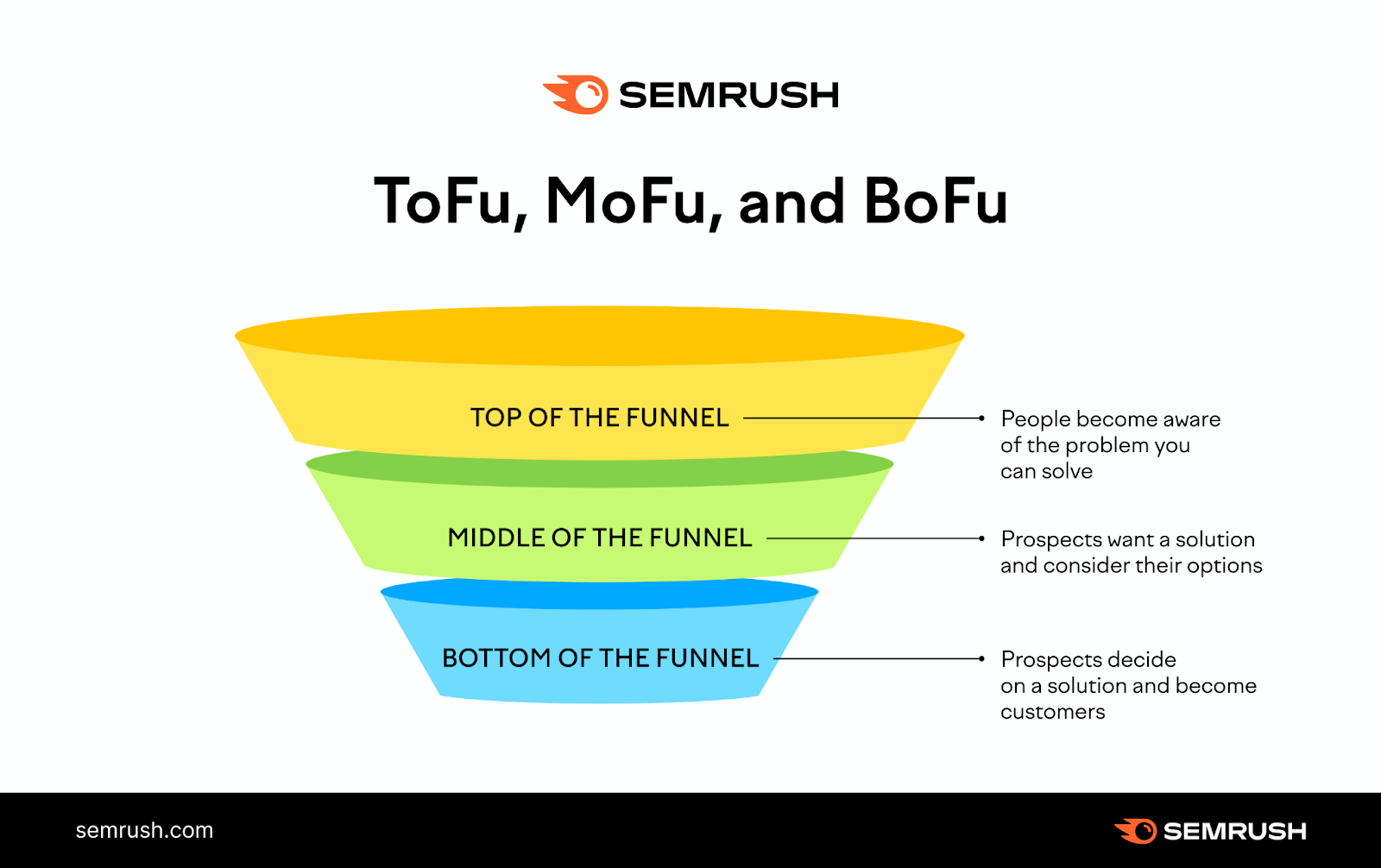
Let’s look at the stages more closely. And find out which types of content are most suitable for each stage.
Top-of-the-Funnel Content
The top of the funnel is the starting point of the buyer journey, and it’s the most populated stage. Here, people aren’t yet ready to buy and might not have heard of your company.
ToFu content should attract your target audience’s attention, offer the best answer to their queries, educate them, and then gently introduce them to your brand.
If you focus on selling at this stage, you might drive people away.
Creating ToFu Content
To attract users at the top of the content marketing funnel, choose content ideas that are relevant to your business. But not overtly promotional.
In other words, address the problems people have before they realize they need your products or services.
That way, you can attract valuable audiences, start to build positive relationships with them, and introduce your offerings in a tactful way later on.
Here are some tips for ToFu content creation:
- Focus on solving the target audience’s pain points
- Include internal links to other useful resources on your site
- Briefly introduce your products or services when relevant
- Use on-page SEO (improving your webpages for search engines and users) to help your content rank higher in search engines
For example, mattress brand Casper has a post about how to fix your sleep schedule. This attracts people who might need a new mattress but don’t know it yet.
The brand establishes expertise and trust by sharing data-backed tips. And gently directs readers toward relevant products or services.
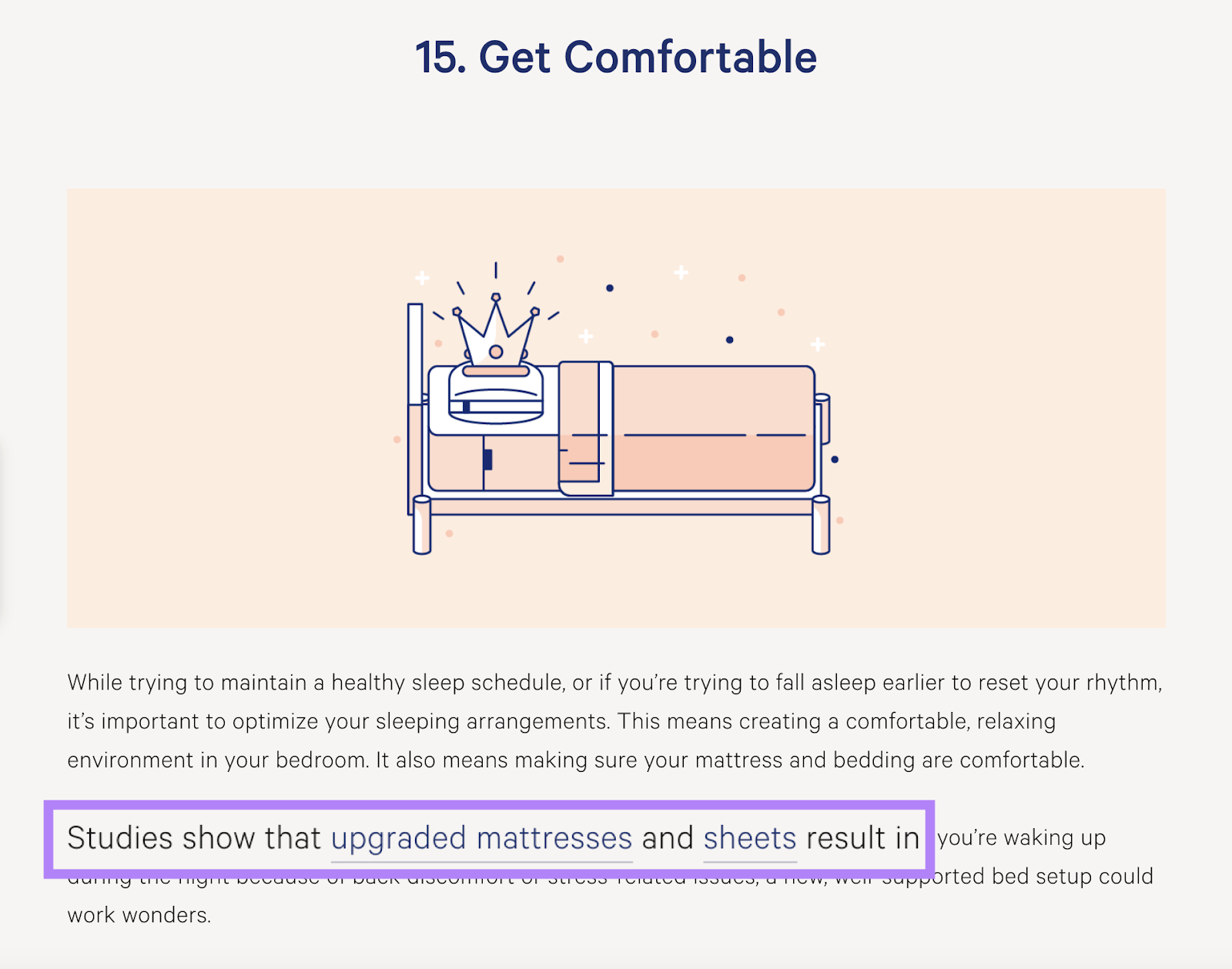
One of the quickest ways to find content ideas is with Semrush’s Topic Research tool.
Just enter a topic to find relevant subtopics you could cover.
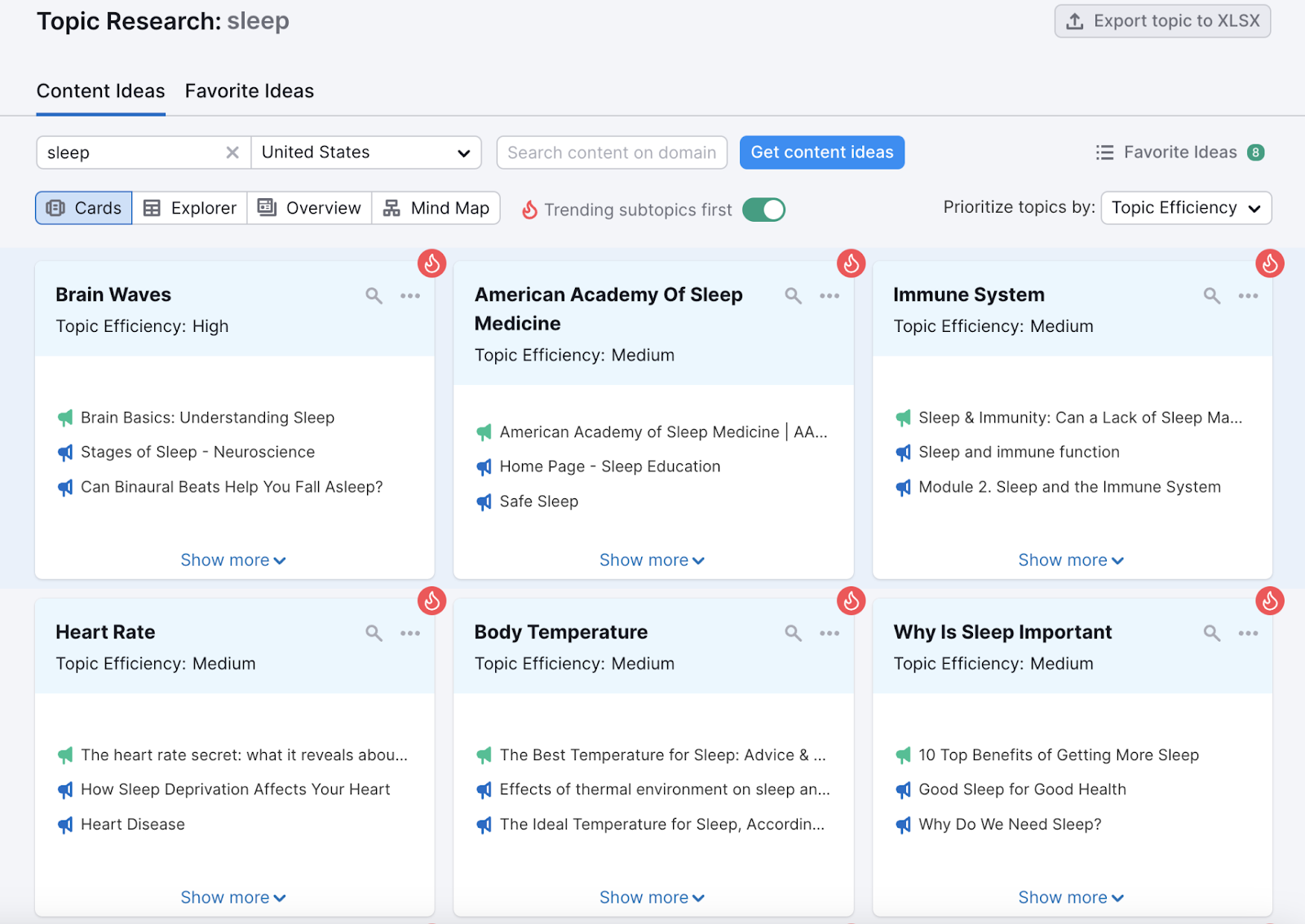
Identifying the Best Types of ToFu Content
These are the top five types of content for attracting traffic to your site, according to our industry survey:
- How-to guides: Text-based tutorials that help users achieve specific goals
- Landing pages: Webpages designed to encourage specific actions (e.g., form submissions)
- Infographics: Images that combine data visualizations with informative text
- Checklists: Resources that help users achieve a goal by checking items off a list
- Ebooks: Digital booklets (usually in PDF format) that cover a specific topic in depth
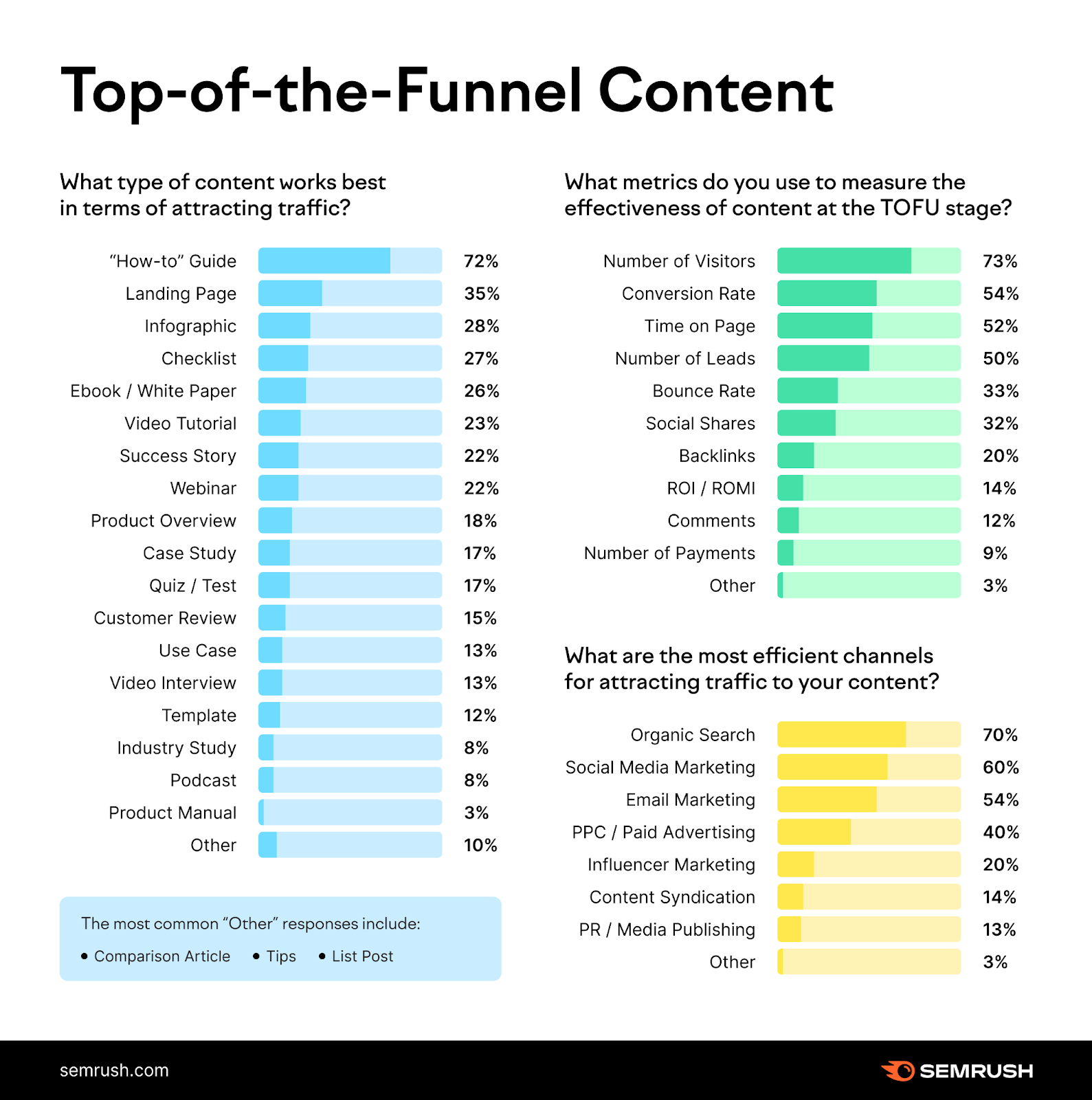
Distributing ToFu Content
The best distribution tactics for ToFu content are as follows, according to our industry survey:
- Organic search (SEO): Getting unpaid rankings in relevant search engine results
- Social media marketing: Sharing your content via platforms like Instagram and LinkedIn
- Email marketing: Reaching out to people who’ve subscribed to your email updates
- PPC/paid advertising: Paying to promote your content through digital advertisements
- Influencer marketing: Incentivizing relevant influencers to promote your content
Analyzing ToFu Content Metrics
The success of ToFu content is usually measured by these content marketing metrics, according to our survey:
- Number of visitors: The number of unique users who visit your site or content
- Conversion rate: The percentage of visits that generate a desired action (e.g., a form submission)
- Time on page: How long the average user remains on a given webpage
- Number of leads: The number of users who express interest in your offerings (often by opting into communications from your business)
- Bounce rate: The percentage of unengaged sessions on your site
You can track metrics like these with Google Analytics or another web analytics tool.
Middle-of-the-Funnel Content
In the middle of the content marketing funnel, users have identified the need for a particular product or service. And they’re evaluating their options.
MoFu content should help target audiences understand the options available to them and position your solution as the best.
Creating MoFu Content
To come up with ideas for MoFu content, consider what factors your customers research before buying.
For example:
- Which brand should I buy from?
- What product or service type is right for me?
- What are the benefits of upgrading?
By helping people answer these kinds of questions, you can build trust with high-value prospects. And guide them toward a buying decision.
For example, mattress retailer Dreams has a mattress types guide:
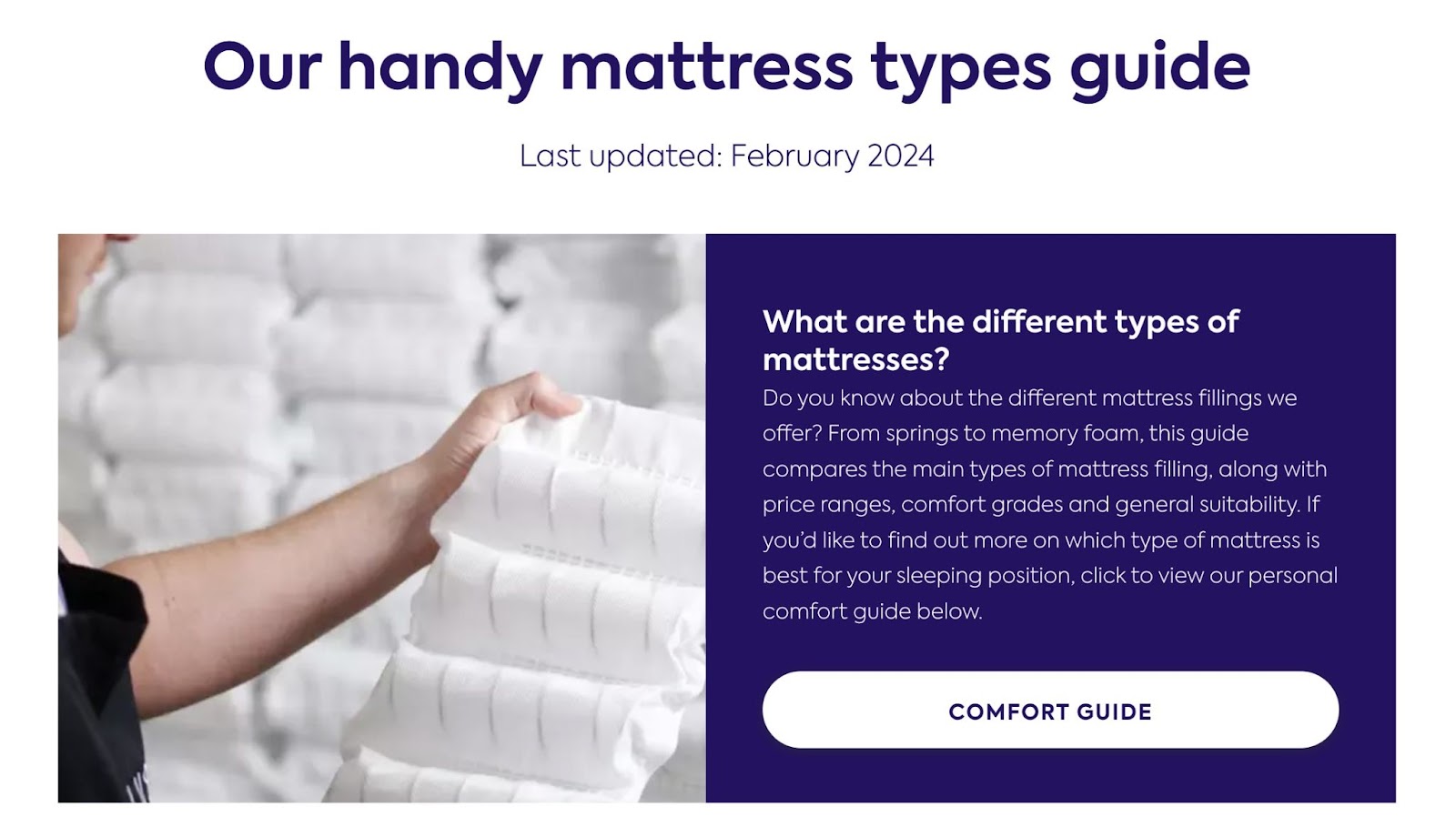
You can afford to be self-promotional at this stage. Where appropriate, detail the benefits of your offering. And how it differs from competitors’.
But, you should provide impartial advice, too. To build trust with your audience.
The middle of the funnel is also a good place for lead generation. Because users at this stage are more willing to give their contact information in exchange for access to high-quality content.
You can then nurture the leads you acquire. This means maintaining relationships with them and guiding them toward the bottom of the funnel.
Identifying the Best Types of MoFu Content
These are the best types of content for generating leads, according to our survey:
- How-to guides: Text-based tutorials that helps users achieve a specific goal
- Product overviews: Detailed information about product features, benefits, specifications, etc.
- Case studies: Data-led reports about customers’ successes with a product or service
- Landing pages: Webpages designed to encourage specific actions (e.g., form submissions)
- Webinars: Online, interactive presentations about topics related to your business
And these are the best types of content for nurturing leads:
- Success stories: Story-driven reports about customers’ successes with a product or service
- Product overviews: Detailed information about product features, benefits, specifications, etc.
- Case studies: Data-led reports about customers’ successes with a product or service
- How-to guides: Text-based tutorials that helps users achieve a specific goal
- Customer reviews: Positive testimonials from previous customers
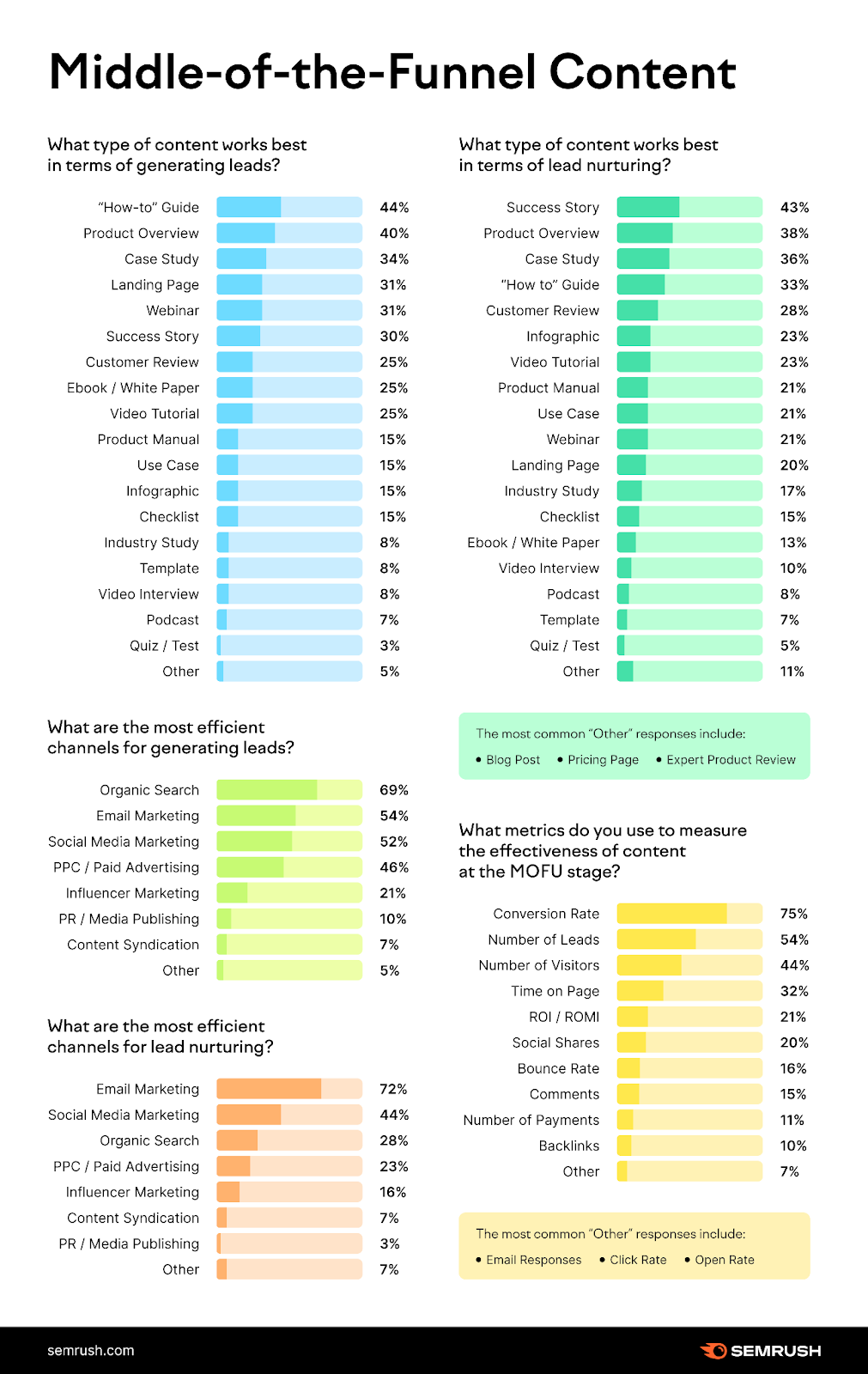
The content types are more solution-oriented to help nurture prospective customers into seeing the true benefits of your products or services.
For example, case studies can show how your products or services have affected other customers in positive and measurable ways.
But as motivation varies a lot at this stage, you should offer a wide choice of convincing materials and show different ways of using your products or services.
Distributing MoFu Content
The best channels for generating leads are as follows, according to our industry survey:
- Organic search (SEO): Getting unpaid rankings in relevant search engine results
- Email marketing: Reaching out to people who’ve subscribed to your email updates
- Social media marketing: Sharing your content via platforms like Instagram and LinkedIn
- PPC/paid advertising: Paying to promote your content through digital advertisements
- Influencer marketing: Incentivizing relevant influencers to promote your content
The best channels for nurturing leads are the same but in a slightly different order:
- Email marketing
- Social media marketing
- Organic search (SEO)
- PPC/paid advertising
- Influencer marketing
Analyzing MoFu Content Metrics
The success of MoFu content is usually measured by these metrics, according to our survey:
- Conversion rate: The percentage of visits that generate a desired action (e.g., a form submission)
- Number of leads: The number of users who express interest in your offerings (often by opting into communications from your business)
- Number of visitors: The number of unique users who visit your site or content
- Time on page: How long the average user remains on a given webpage
- ROI/ROMI: Return on (marketing) investment is how much revenue your marketing activities generate compared to their costs (e.g., a campaign that cost $10 and generated $20 had a 100% ROMI)
Bottom-of-the-Funnel Content
At the bottom of the content marketing funnel, prospects are ready to make a purchase. And they may or may not have chosen a provider.
You need to focus on giving prospects motivation to buy from you.
Creating BoFu Content
BoFu content should center around your products or services.
You need to emphasize any unique selling points, answer last-minute questions shoppers might have, and use psychology to your advantage.
For instance:
- Create a sense of urgency: Discourage prospects from delaying their purchase by making them aware of low stock levels, limited-time deals, etc.
- Leverage social proof: People look to the actions and opinions of their peers before making a decision. So, it’s a good idea to talk about the number of happy customers you have.
- Establish authority: Showcase accreditations (e.g., industry certifications) to assure prospects that you’re trustworthy and give them the confidence to make their purchase
- Use a call to action: Prompt visitors into action by telling them exactly what to do (e.g., “Start Your Free Trial”)
This Serta product page provides detailed information about the mattress’s features and benefits:
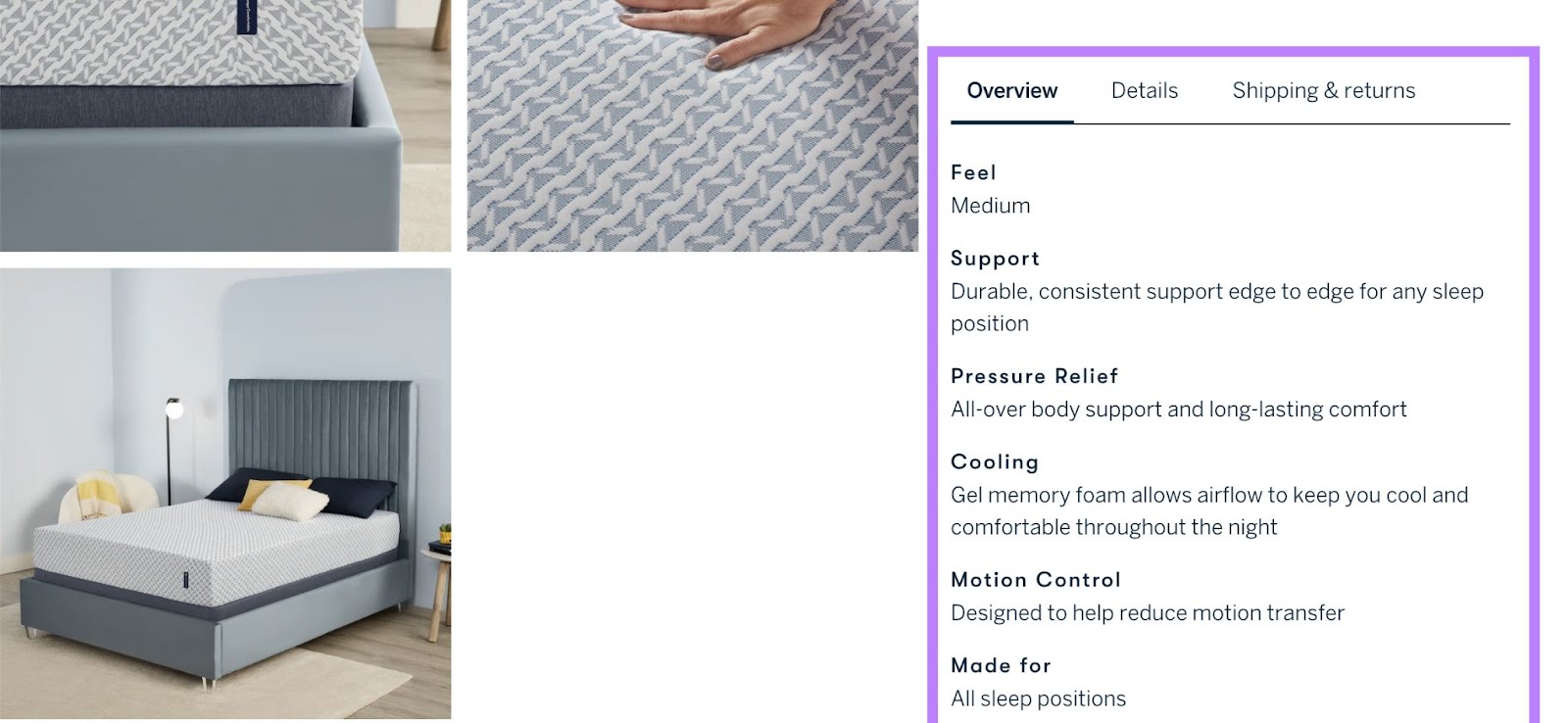
It also highlights many of the company’s unique selling points:
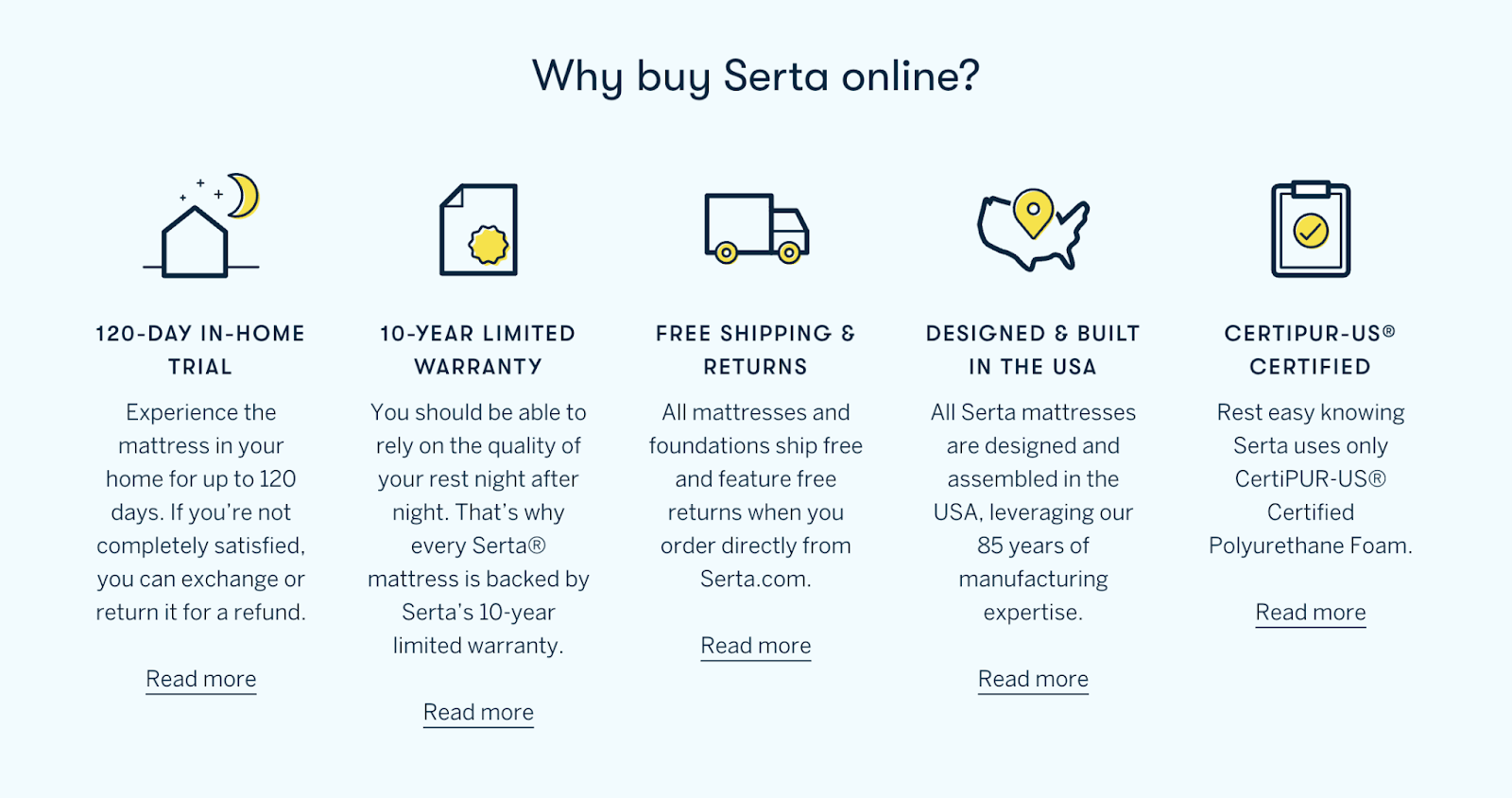
And displays reviews from happy customers:

Identifying the Best Types of BoFu Content
According to our survey, the top-performing content types for the BoFu stage are:
- Product overviews: Detailed information about product features, benefits, specifications, etc.
- Customer reviews: Positive testimonials from previous customers
- Success stories: Story-driven reports about customers’ successes with a product or service
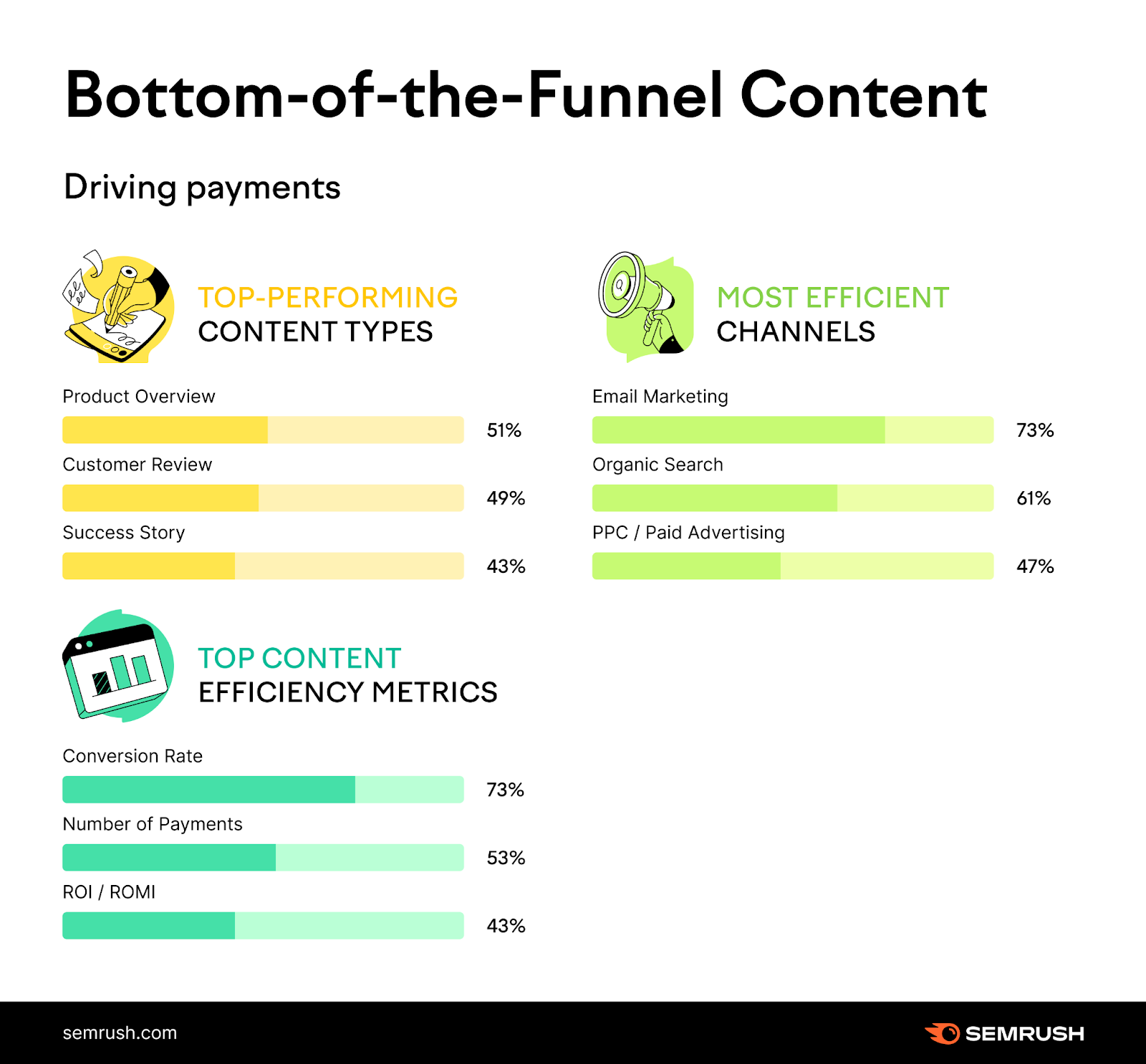
Distributing BoFu Content
These are the most efficient ways to get BoFu content noticed, according to our industry survey:
- Email marketing: Reaching out to people who’ve subscribed to your email updates
- Organic search (SEO): Getting unpaid rankings in relevant search engine results
- PPC/paid advertising: Paying to promote your content through digital advertisements
Analyzing BoFu Content Metrics
Our industry respondents say the top BoFu content efficiency metrics are:
- Conversion rate: The percentage of visits that generate a desired action (e.g., a form submission)
- Number of payments: The number of sales transactions made by users who visit a given page
- ROI/ROMI: Return on (marketing) investment is how much revenue your marketing activities generate compared to their costs (e.g., a campaign that cost $10 and generated $20 had a 100% ROMI)
5 Tips for Building a Content Marketing Funnel
Here are five tips to help you build a robust content marketing funnel:
1. Understand Your Target Audience
It’s important to understand your target audiences’ needs, preferences, and behaviors at every stage of the buying journey.
Only then can you create and distribute content in the most effective ways possible.
For example, let’s consider how young professionals might engage with a mattress brand’s content at each stage of the funnel:
- ToFu: Follow another site’s link to your blog post about reducing nightly screen time
- MoFu: Look at mattress recommendations from their favorite influencers on TikTok
- BoFu: Make a decision based on key factors like price and return policy
By comparison, here’s how older adults might engage with the same business:
- ToFu: Follow a Google result to your blog post about reducing back pain
- MoFu: Take a quiz to determine if it’s time to replace their old mattress
- BoFu: Make a decision based on brand accreditations and reviews
To learn more about your audience segments, try One2Target.
Enter a few competitors’ domains and click “Analyze.”
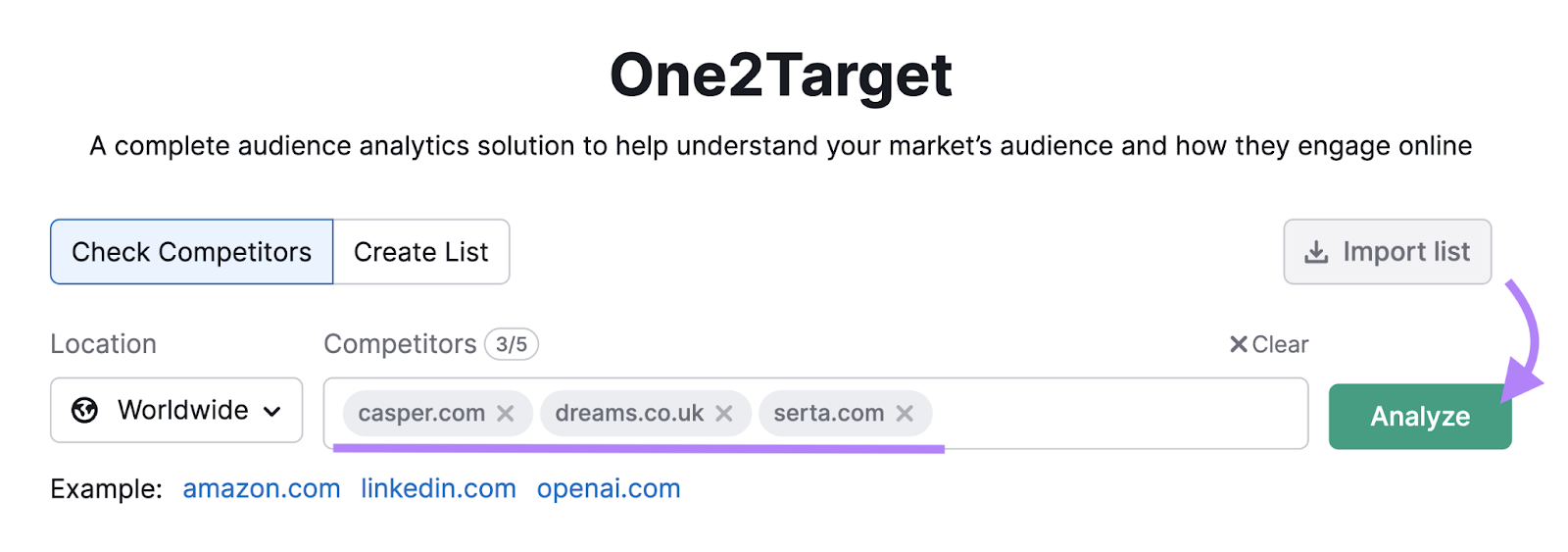
You can then see details about your competitors’ collective audience. Broken down by demographic, socioeconomic, and behavioral information.
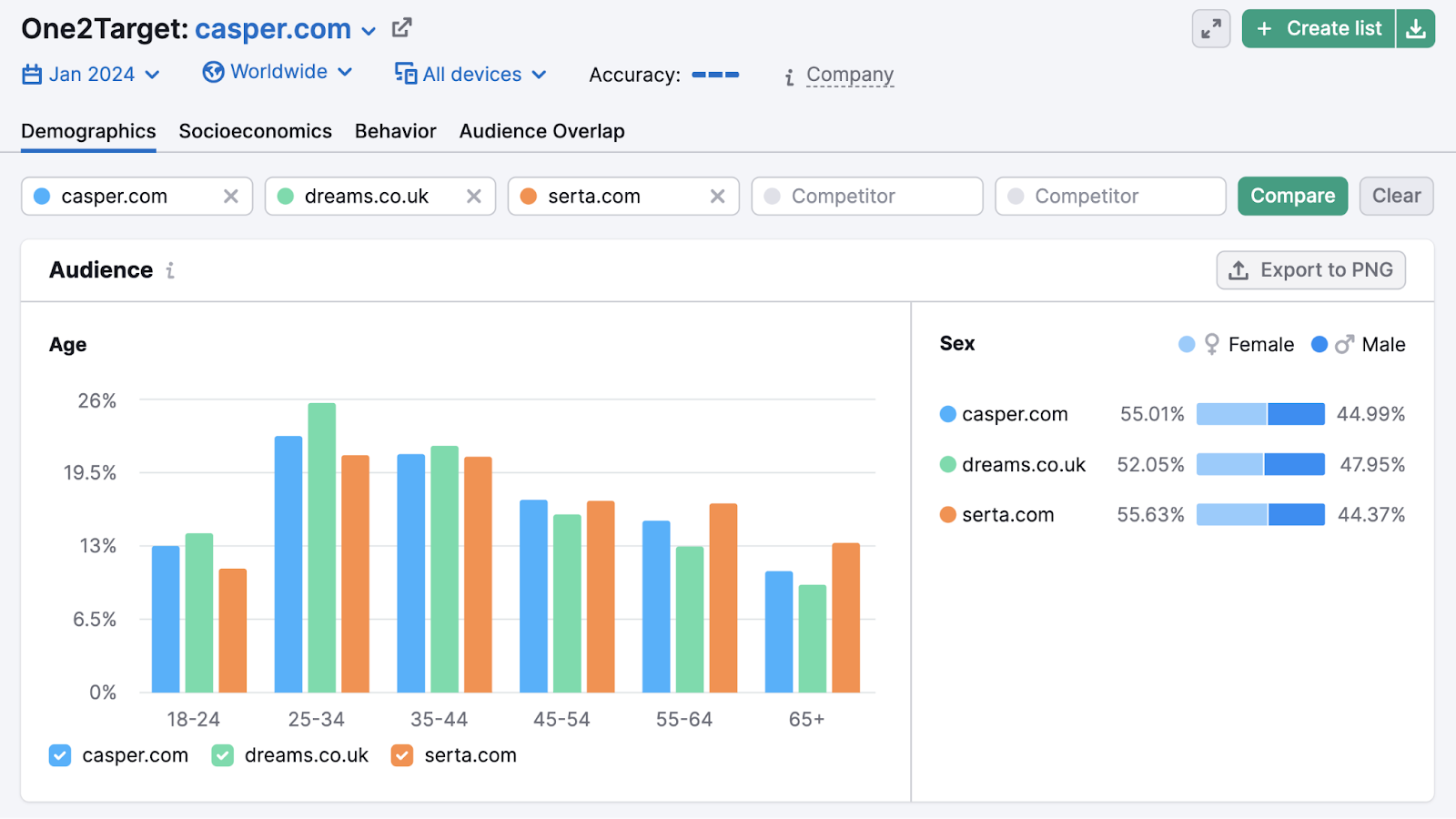
You can even see which social media platforms this audience uses most. To inform your distribution efforts.
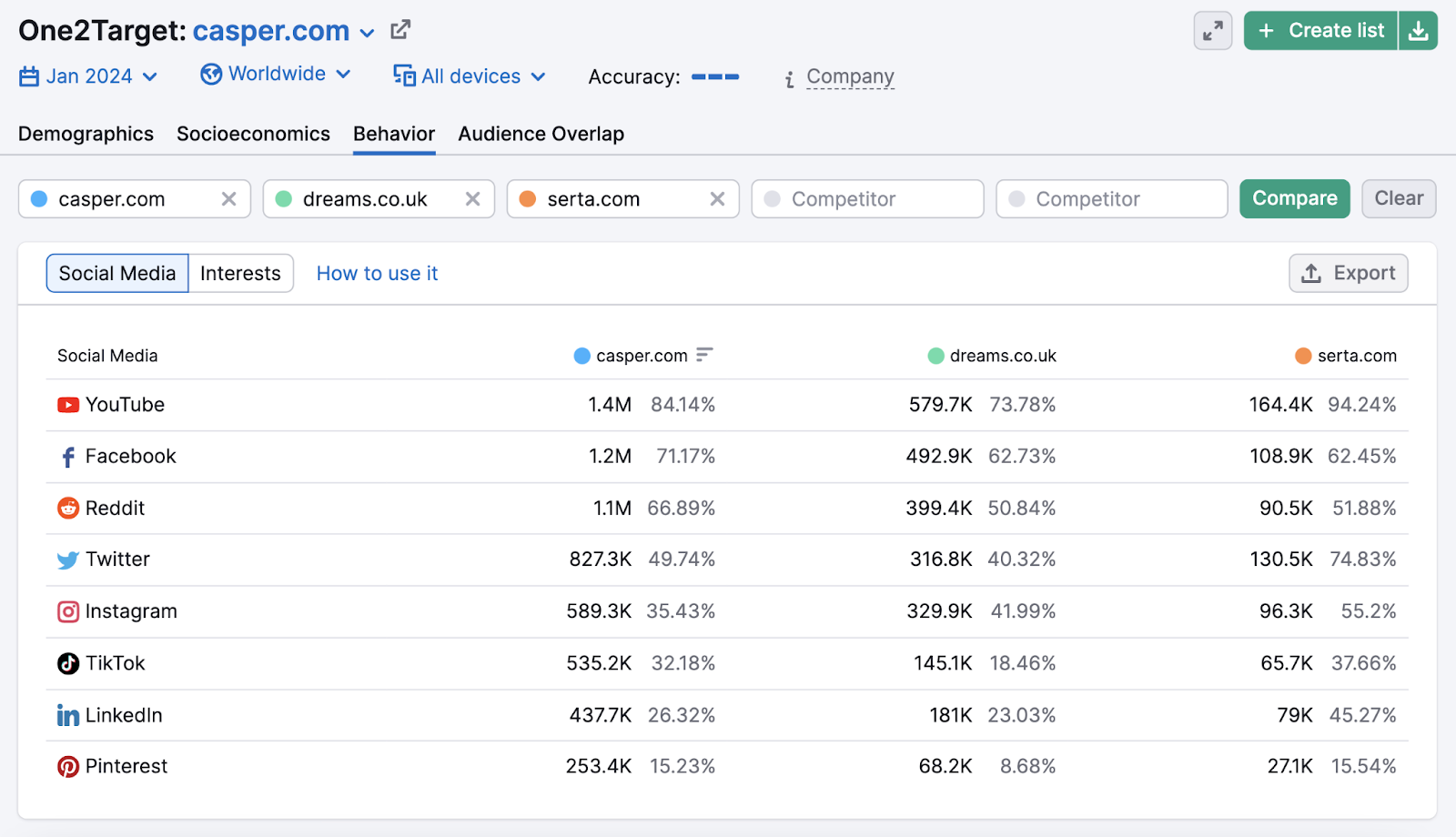
For more information, check out our in-depth guide to learn how to do audience research.
2. Perform Keyword Research
Conducting keyword research helps you find out what people search for in search engines like Google.
You can use it to find out what your target audiences are interested in at every stage of the marketing funnel. And optimize your content accordingly.
To get started, go to Semrush’s Keyword Magic Tool.
Enter a general term related to your business, choose your target country, then click “Search.”

The tool will present a list of keywords that contain your starting term or a close variation.
In the “Intent” column, you’ll see the type of search intent behind each keyword. (The general purpose behind the average user’s search.)
This gives a strong indication of where the user is in the marketing funnel:
|
I |
Informational |
The user wants to find information. They’re probably in the ToFu stage. |
|
C |
Commercial |
The user wants to research brands, products, or services. They’re probably in the MoFu stage. |
|
N |
Navigational |
The user wants to find a specific webpage. They’re probably in the MoFu or BoFu stage. |
|
T |
Transactional |
The user wants to complete an action, such as a purchase. They’re probably in the BoFu stage. |
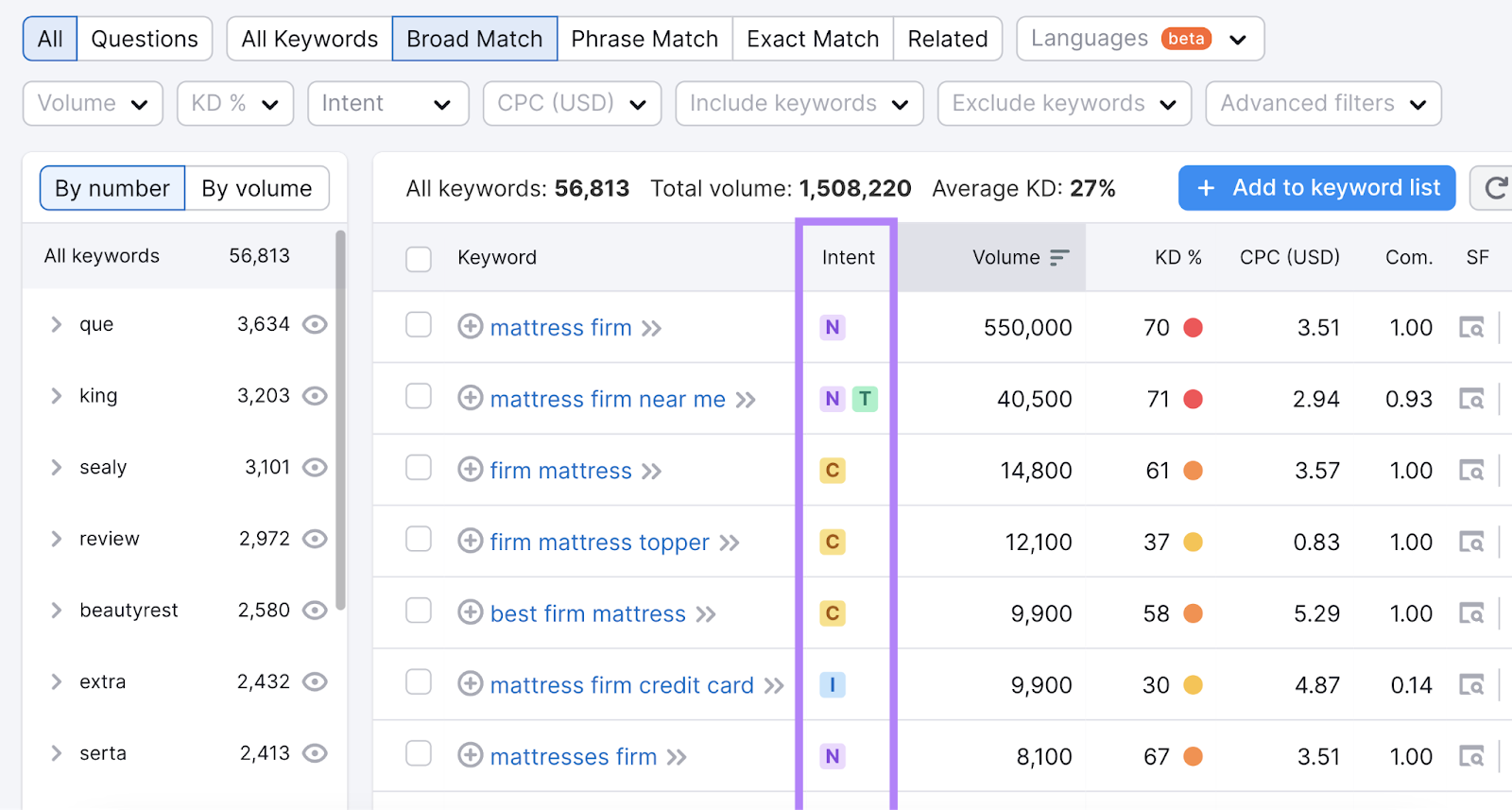
We also recommend that you look at:
- Volume: The average number of monthly searches for the keyword
- KD %: The keyword difficulty score, which measures ranking difficulty out of 100
When you identify a keyword of interest, click the icon to the right of the number in the “Com.” column.
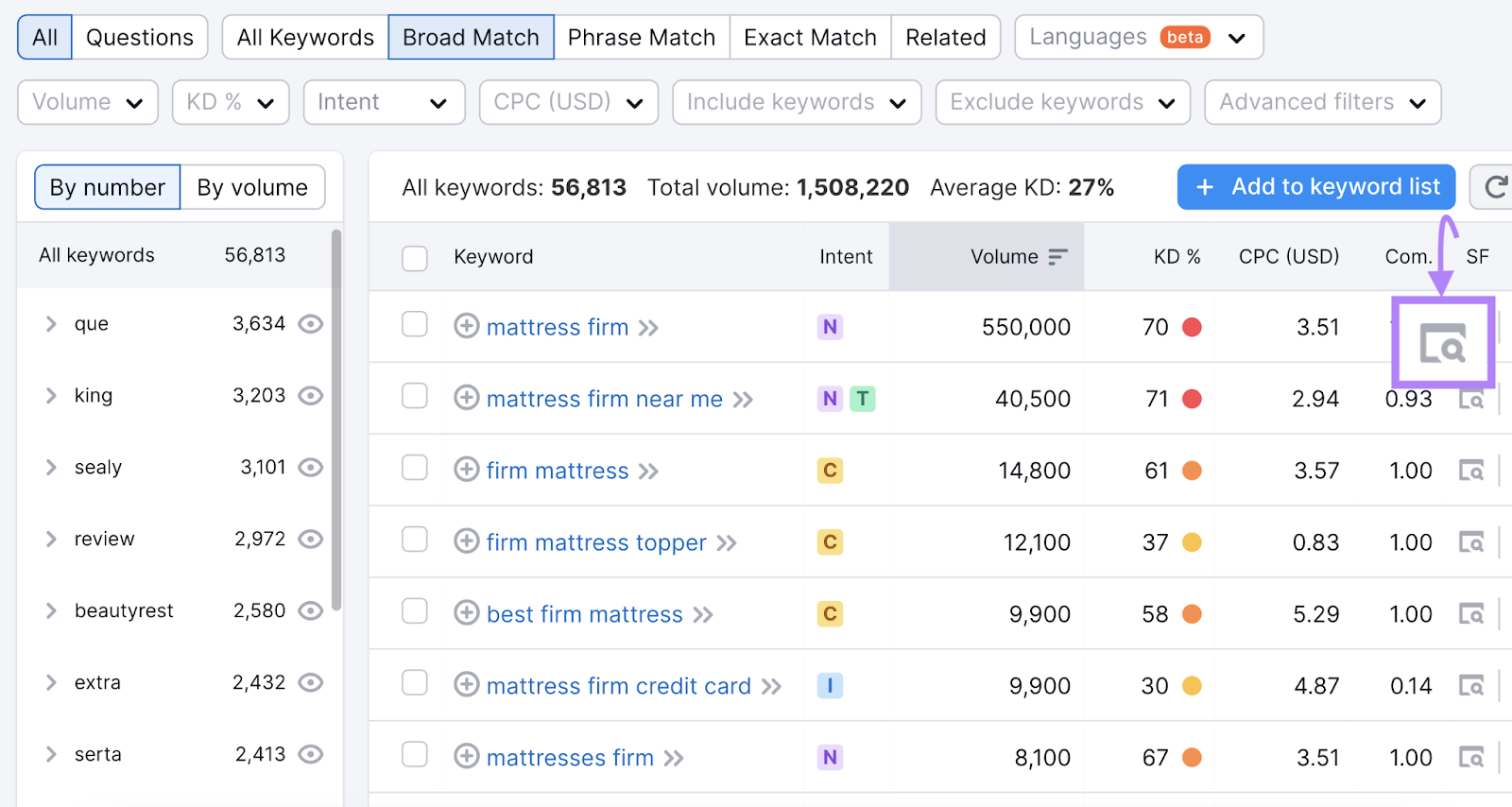
This lets you see the Google search results. So you can determine what kind of content is most likely to perform well. And get a better understanding of your potential visitors.
For example, the results page for “best firm mattress” is dominated by comparison guides (MoFu). Rather than product pages (BoFu).
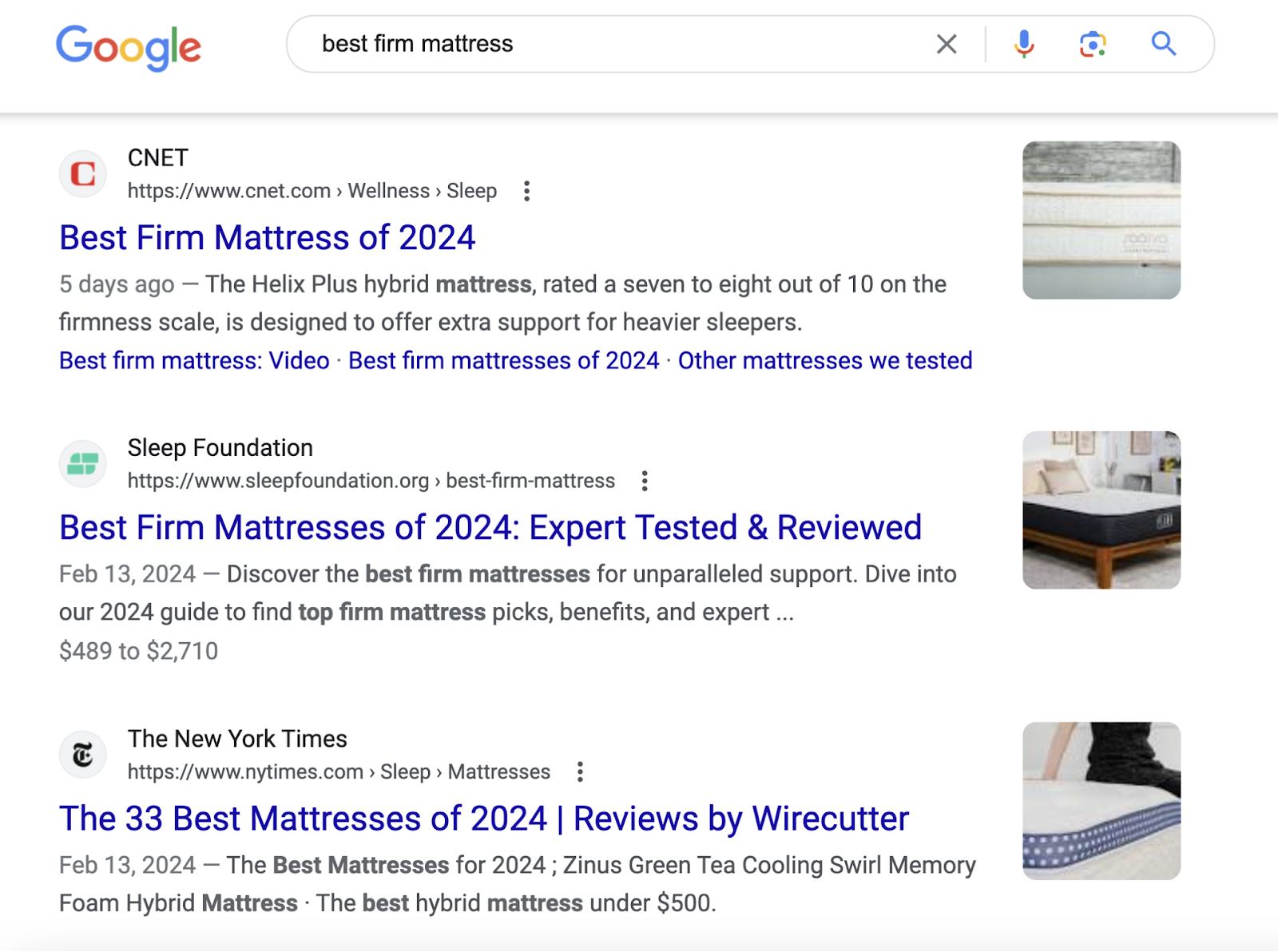
This suggests that people who search “best firm mattress” aren’t yet ready to buy. So, you should use that keyword in a MoFu piece that helps readers evaluate their options.
3. Analyze Your Competitors’ Content
Get insights and inspiration for your own content marketing funnel by analyzing competitors’ content.
Doing this helps you:
- Identify content gaps: Find out whether your audience has unmet needs you can address. By filling these gaps, you can direct more prospects into your content funnel.
- Gather performance metrics: Learn from your competitors’ successes and mistakes. And create benchmarks for your own content strategy.
- Differentiate your content: See what your competitors are already doing so you can find ways to stand out
One of the best ways to gather competitive insights is with Semrush’s Traffic Analytics tool.
Choose your target location, enter up to five competitors’ domains, and then click “Analyze.”
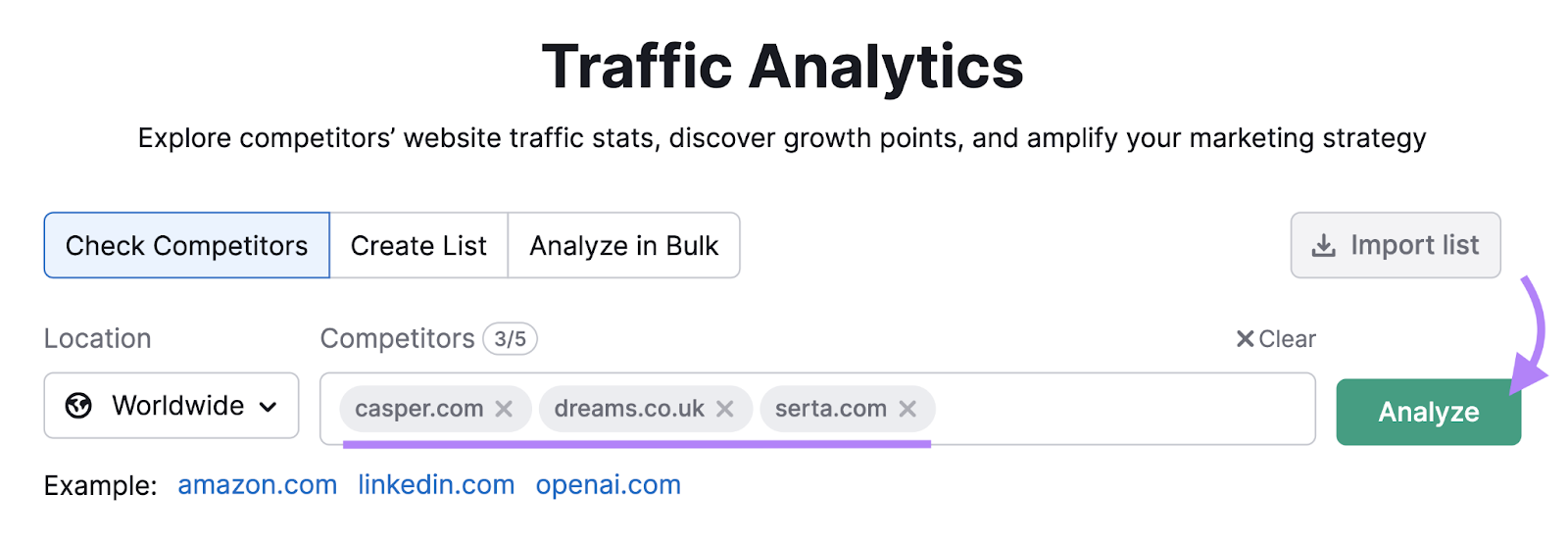
In the “Top Pages” report, you can identify pages with growing or declining traffic volumes. And newly detected pages.
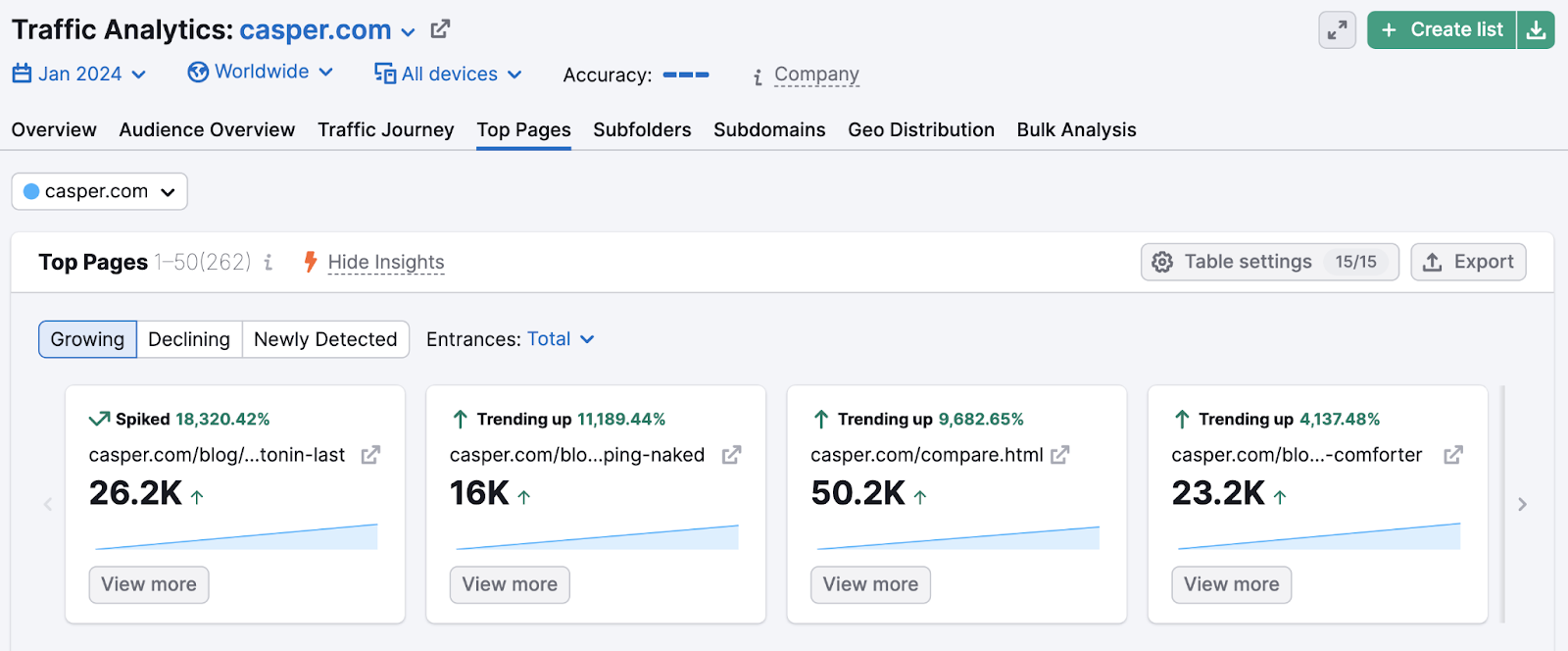
Further down, you’ll find data for all listed URLs. Including:
- Number of visitors
- Average visit duration
- Traffic sources
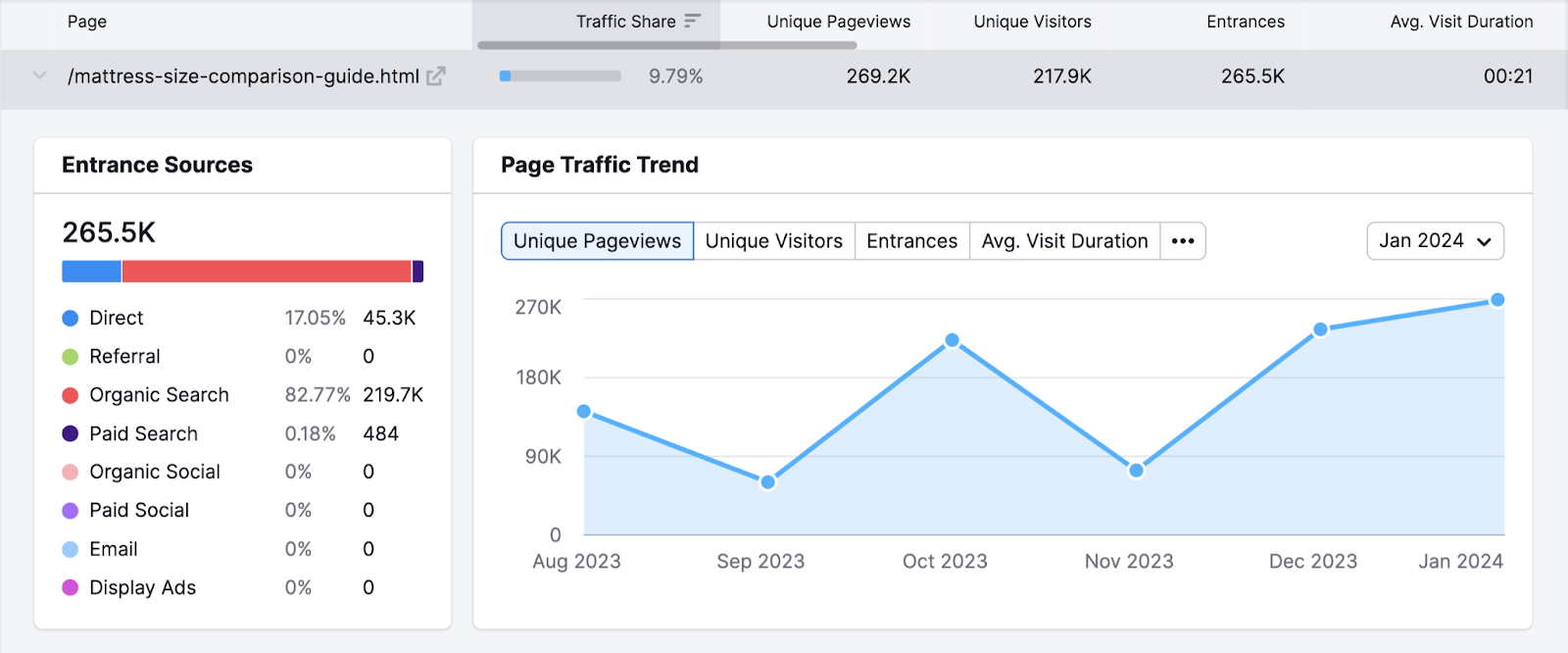
4. Get the Balance Right
Generally, it’s a good idea to work on lower-funnel content before upper-funnel content. Because there’s little point attracting prospects you’ll struggle to convert.
But don’t fall into the trap of focusing too much on BoFu content.
Not only will this seriously limit your reach, but it’ll harm your ability to build trust with prospects.
To maximize conversions, you need a good balance of ToFu, MoFu, and BoFu content.
How do you find the right balance?
By measuring metrics in each stage of the content marketing funnel. And taking corrective action if you spot a weakness in any area.
The easiest way to do this is with the ImpactHero app.
It shows whether your performance is declining in any funnel stage:

And it also lets you see which traffic sources bring the most/least visitors, user activities, and leads:
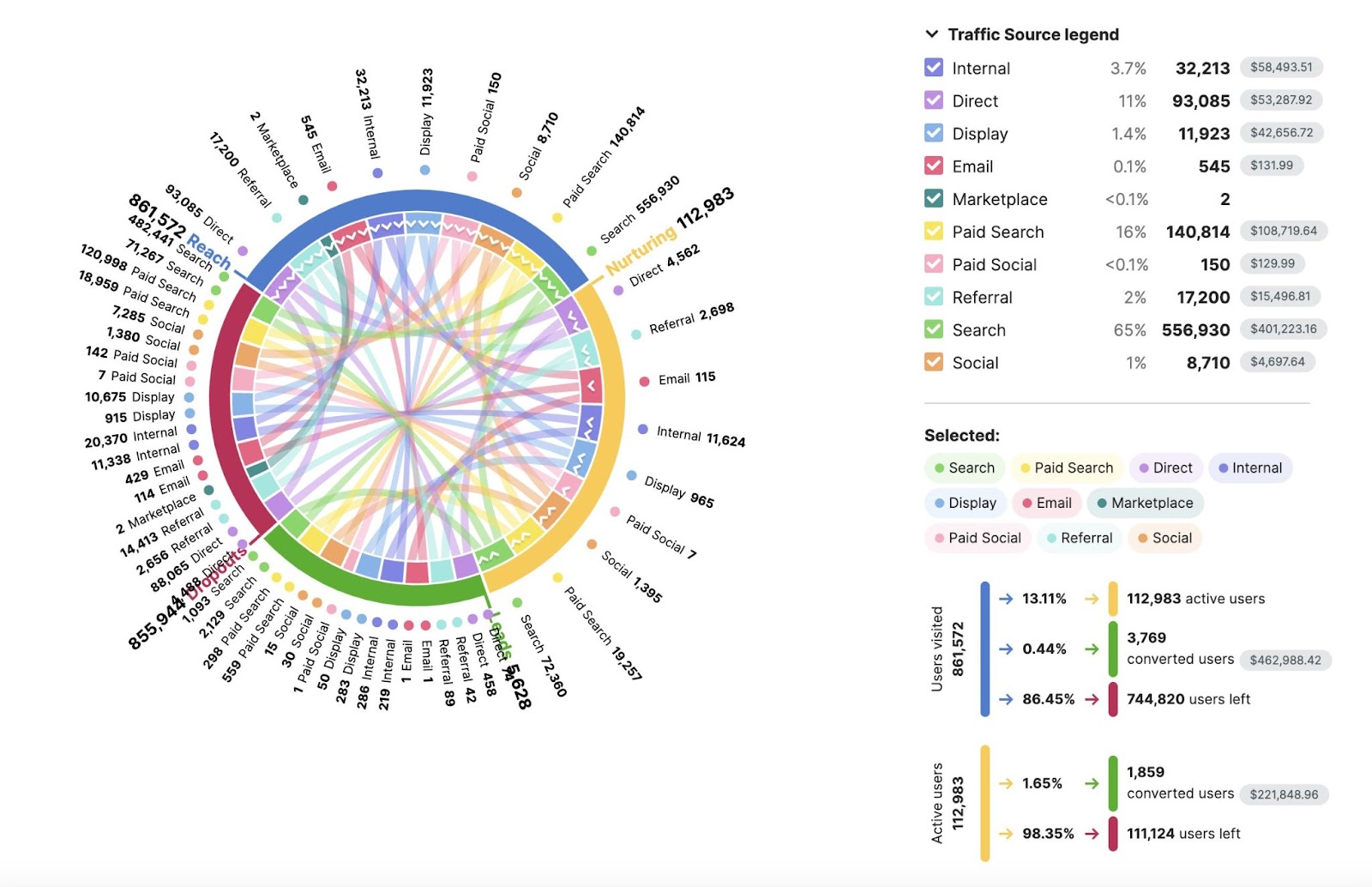
For the full workflow, check out this ImpactHero guide.
5. Build Customer Loyalty
Loyal customers can go through your content marketing funnel again and again. They might even direct other people to your funnel.
So, you should also create content that builds customer loyalty. Meaning it’s aimed at those who’ve already gone through the decision phase.
For example:
- Product or service updates: Ensure customers know about the newest features
- Exclusive content: Create content that’s accessible to previous customers only
- Tutorials: Walk customers through how to use your products or services most effectively
Make Your Content Funnel a Success
There’s a lot that goes into creating a robust content marketing funnel. But you can streamline the process with the right content creation tools.
For example, a free Semrush trial lets you:
- Identify popular content topics and keywords
- Learn about your target audience
- Optimize your content for search engines
- Analyze competitors’ content
And much more.
Source link : Semrush.com
